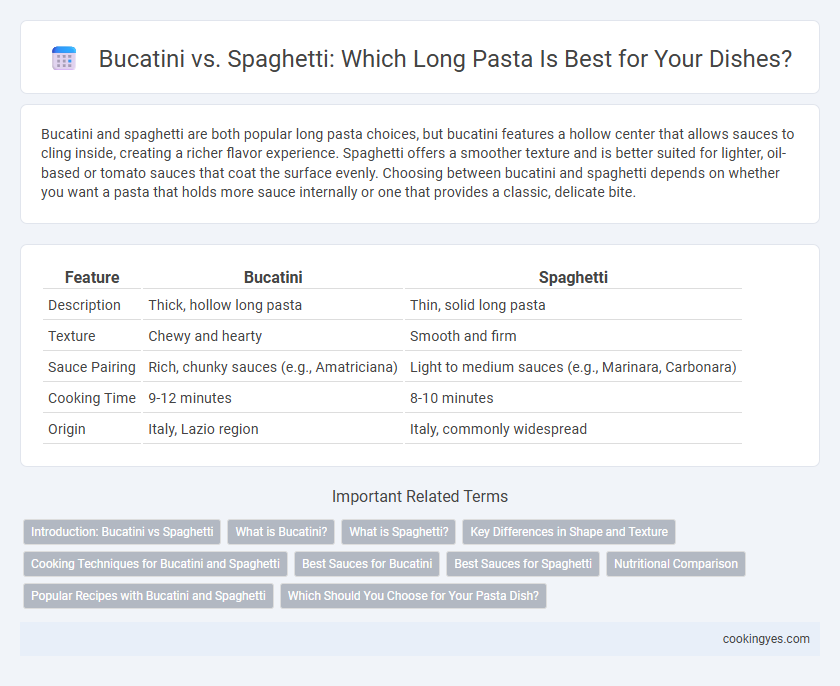Bucatini and spaghetti are both popular long pasta choices, but bucatini features a hollow center that allows sauces to cling inside, creating a richer flavor experience. Spaghetti offers a smoother texture and is better suited for lighter, oil-based or tomato sauces that coat the surface evenly. Choosing between bucatini and spaghetti depends on whether you want a pasta that holds more sauce internally or one that provides a classic, delicate bite.
Table of Comparison
| Feature | Bucatini | Spaghetti |
|---|---|---|
| Description | Thick, hollow long pasta | Thin, solid long pasta |
| Texture | Chewy and hearty | Smooth and firm |
| Sauce Pairing | Rich, chunky sauces (e.g., Amatriciana) | Light to medium sauces (e.g., Marinara, Carbonara) |
| Cooking Time | 9-12 minutes | 8-10 minutes |
| Origin | Italy, Lazio region | Italy, commonly widespread |
Introduction: Bucatini vs Spaghetti
Bucatini features a hollow center that allows sauces to cling inside the pasta, enhancing flavor absorption, while spaghetti offers a smooth, solid texture ideal for a wide range of sauces. Both long pasta varieties originate from Italian cuisine, with bucatini traditionally used in dishes like Bucatini all'Amatriciana, and spaghetti famously paired with tomato-based sauces such as Spaghetti alla Carbonara. The choice between bucatini and spaghetti influences the overall texture and sauce interaction in long pasta recipes.
What is Bucatini?
Bucatini is a thick, hollow pasta that closely resembles spaghetti but features a unique central hole, allowing it to hold sauces inside as well as on the surface. This tubular structure enhances the texture and flavor absorption in long pasta dishes, making it an excellent choice for rich, hearty sauces such as amatriciana or carbonara. Compared to spaghetti, bucatini provides a more substantial bite and a distinctive eating experience due to its hollow center.
What is Spaghetti?
Spaghetti is a long, thin, cylindrical pasta made from durum wheat semolina, known for its smooth surface and versatile use in various Italian dishes. It cooks quickly and pairs well with a variety of sauces, such as marinara, carbonara, and aglio e olio, making it a staple in Italian cuisine. Unlike bucatini, spaghetti lacks a hollow center, resulting in a different sauce absorption and texture experience.
Key Differences in Shape and Texture
Bucatini is a thick, hollow pasta that allows sauces to fill its center, creating a unique texture contrast with a slightly chewy bite, while spaghetti is a solid, thin strand known for its smooth surface and delicate mouthfeel. The hollow core of bucatini makes it ideal for heartier sauces that cling inside and out, enhancing flavor absorption, whereas spaghetti's uniform shape complements lighter, more fluid sauces that coat evenly. These key differences in shape and texture significantly influence the overall eating experience and suitability in pasta dishes.
Cooking Techniques for Bucatini and Spaghetti
Bucatini requires slightly longer cooking times than spaghetti due to its thicker center hole, ensuring an al dente texture without a chewy core. Spaghetti benefits from boiling in rapidly boiling salted water and frequent stirring to prevent clumping, while bucatini often calls for gentle rolling during cooking to maintain even heat distribution inside the hollow tube. Both pastas absorb sauces differently: bucatini's hollow center traps rich sauces for intense flavor, whereas spaghetti's thin strands allow for quicker sauce adherence and uniform coating.
Best Sauces for Bucatini
Bucatini's hollow center makes it ideal for thicker, oil-based sauces like Amatriciana and Carbonara, allowing the flavors to seep inside the pasta for a richer taste experience. Unlike spaghetti, bucatini holds chunky tomato sauces and creamy cheese sauces better due to its sturdy texture and tubular shape. Pairing bucatini with robust sauces featuring pancetta, garlic, and Pecorino Romano enhances the overall dish complexity and satisfaction.
Best Sauces for Spaghetti
Spaghetti pairs exceptionally well with classic tomato-based sauces like marinara and Bolognese, allowing the thin, smooth strands to absorb flavors evenly. Light oil-based sauces such as aglio e olio or simple garlic and olive oil enhance spaghetti's delicate texture without overpowering it. In contrast to bucatini, which suits thicker, chunky sauces due to its hollow center, spaghetti's solid form excels with smooth, well-emulsified sauces for optimal flavor coating.
Nutritional Comparison
Bucatini and spaghetti offer similar calorie counts and carbohydrate content, but bucatini provides slightly more fiber due to its hollow center, enhancing digestive health. Both pastas contain comparable protein levels, with bucatini offering a marginal increase in micronutrients like iron and B vitamins from durum wheat. Choosing bucatini may support better satiety and nutrient absorption in long pasta dishes, making it a nutritious alternative to traditional spaghetti.
Popular Recipes with Bucatini and Spaghetti
Bucatini and spaghetti both shine in classic long pasta dishes, with bucatini's hollow center ideal for capturing rich sauces in recipes like Amatriciana and Cacio e Pepe. Spaghetti's thinner, smooth strands excel in dishes such as Spaghetti Carbonara and Spaghetti Aglio e Olio, where a lighter sauce evenly coats the pasta. Choosing between bucatini and spaghetti depends on the desired sauce texture and the traditional flavor profile of popular Italian recipes.
Which Should You Choose for Your Pasta Dish?
Bucatini offers a thicker texture and a hollow center that holds sauces better, making it ideal for rich, hearty pasta dishes like amatriciana or carbonara. Spaghetti, with its thinner, solid strands, provides a lighter bite and pairs well with delicate tomato or olive oil-based sauces. Choosing between bucatini and spaghetti depends on the sauce consistency and the desired mouthfeel of the long pasta dish.
Bucatini vs Spaghetti for long pasta dishes Infographic

 cookingyes.com
cookingyes.com